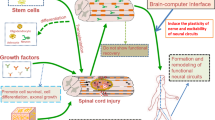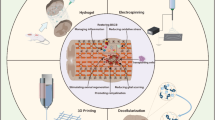Abstract
The integrity of the neuronal membrane is crucial for its function and cellular survival; thus, ineffective repair of damaged membranes may be one of the key elements underlying the neuronal degeneration and overall functional loss that occurs after spinal cord injury (SCI). it has been shown that polyethylene glycol (PEG) can reseal axonal membranes following various injuries in multiple in vitro and in vivo injury models. in addition, PEG may also directly prevent the effects of mitochondria-derived oxidative stress on intracellular components. Thus, PEG repairs mechanically injured cells by at least two distinct pathways: resealing of the disrupted plasma membrane and direct protection of mitochondria. Besides repairing primary membrane damage, PEG treatment also results in significant attenuation of oxidative stress, likely due to its capacity to reseal the membrane, thereby breaking the cycle of cellular damage and free-radical production. Based on this, in addition to the practicality of its application, we expect that PEG may be established as an effective treatment for SCI where membrane disruption and mitochondrial damage are implicated.
Similar content being viewed by others
References
McNeil PL, Kirchhausen T. An emergency response team for membrane repair. Nat Rev Mol Cell Biol 2005, 6: 499–505.
Bansal D, Miyake K, Vogel SS, Groh S, Chen CC, Williamson R, et al. Defective membrane repair in dysferlin-deficient muscular dystrophy. Nature 2003, 423: 168–172.
McNeil PL, Steinhardt RA. Plasma membrane disruption: repair, prevention, adaptation. Annu Rev Cell Dev Biol 2003, 19: 697–731.
Nehrt A, Hamann K, Ouyang H, Shi R. Polyethylene glycol enhances axolemmal resealing following transection in cultured cells and in ex vivo spinal cord. J Neurotrauma 2010, 27: 15–61.
Schlaepfer WW. Calcium-induced degeneration of axoplasm in isolated segments of rat peripheral nerve. Brain Res 1974, 69: 203–215.
Fiskum G. Mitochondrial participation in ischemic and traumatic neural cell death. J Neurotrauma 2000, 17: 843–855.
Lewen A, Matz P, Chan PH. Free radical pathways in CNS injury. J Neurotrauma 2000, 17: 871–890.
Wieloch T. Mitochondrial involvement in acute neurodegeneration. iUBMB Life 2001, 52: 247–254.
Ray SK, Hogan EL, Banik NL. Calpain in the pathophysiology of spinal cord injury: neuroprotection with calpain inhibitors. Brain Res Brain Res Rev 2003, 42: 169–185.
Wingrave JM, Schaecher KE, Sribnick EA, Wilford GG, Ray SK, Hazen-Martin DJ, et al. Early induction of secondary injury factors causing activation of calpain and mitochondriamediated neuronal apoptosis following spinal cord injury in rats. J Neurosci Res 2003, 73: 95–104.
Borgens RB, Jaffe LF, Cohen MJ. Large and persistent electrical currents enter the transected lamprey spinal cord. Proc Natl Acad Sci U S A 1980, 77: 1209–1213.
Howard AC, McNeil AK, McNeil PL. Promotion of plasma membrane repair by vitamin E. Nat Commun 2011, 2: 597.
Xie X, Barrett JN. Membrane resealing in cultured rat septal neurons after neurite transection: evidence for enhancement by Ca2+-triggered protease activity and cytoskeletal disassembly. J Neurosci 1991, 11: 3257–3267.
Spira ME, Benbassat D, Dormann A. Resealing of the proximal and distal cut ends of transected axons: electrophysiological and ultrastructural analysis. J Neurobiol 1993, 24: 300–316.
Krause TL, Fishman HM, Ballinger ML, Bittner GD. Extent and mechanism of sealing in transected giant axons of squid and earthworms. J Neurosci 1994, 14: 6638–6651.
Eddleman CS, Ballinger ML, Smyers ME, Godell CM, Fishman HM, Bittner GD. Repair of plasmalemmal lesions by vesicles. Proc Natl Acad Sci U S A 1997, 94: 4745–4750.
Shi R, Asano T, Vining NC, Blight AR. Control of membrane sealing in injured mammalian spinal cord axons. J Neurophysiol 2000, 84: 1763–1769.
Shi R, Borgens RB. Anatomical repair of nerve membranes in crushed mammalian spinal cord with polyethylene glycol. J Neurocytol 2000, 29: 633–643.
Shi R, Pryor JD. Temperature dependence of membrane sealing following transection in mammalian spinal cord axons. Neuroscince 2000, 98: 157–166.
Pettus EH, Christman CW, Giebel ML, Povlishock JT. Traumatically induced altered membrane permeability: its relationship to traumatically induced reactive axonal change. J Neurotrauma 1994, 11: 507–522.
Pettus EH, Povlishock JT. Characterization of a distinct set of intra-axonal ultrastructural changes associated with traumatically induced alteration in axolemmal permeability. Brain Res 1996, 722: 1–11.
Yawo H, Kuno M. How a nerve fiber repairs its cut end: involvement of phospholipase A2. Science 1983, 222: 1351–1352.
Smith DH, Wolf JA, Lusardi TA, Lee VM, Meaney DF. High tolerance and delayed elastic response of cultured axons to dynamic stretch injury. J Neurosci 1999, 19: 4263–4269.
Geddes DM, Cargill RS 2nd, LaPlaca MC. Mechanical stretch to neurons results in a strain rate and magnitude-dependent increase in plasma membrane permeability. J Neurotrauma 2003, 20: 1039–1049.
Shi R, Borgens RB. Acute repair of crushed guinea pig spinal cord by polyethylene glycol. J Neurophysiol 1999, 81: 2406–2414.
Shi R, Borgens RB, Blight AR. Functional reconnection of severed mammalian spinal cord axons with polyethylene glycol. J Neurotrauma 1999, 16: 727–738.
Shi R, Qiao X, Emerson N, Malcom A. Dimethylsulfoxide enhances CNS neuronal plasma membrane resealing after injury in low temperature or low calcium. J Neurocytol 2001, 30: 829–839.
Shi R. The dynamics of axolemmal disruption in guinea pig spinal cord following compression. J Neurocytol 2004, 33: 203–211.
Young W, Yen V, Blight A. Extracellular calcium ionic activity in experimental spinal cord contusion. Brain Res 1982, 253: 105–113.
Stokes BT, Fox P, Hollinden G. Extracellular calcium activity in the injured spinal cord. Exp Neurol 1983, 80: 561–572.
Lucas JH, Gross GW, Emery DG, Gardner CR. Neuronal survival or death after dendrite transection close to the perikaryon: correlation with electrophysiologic, morphologic, and ultrastructural changes. Cent Nerv Syst Trauma 1985, 2: 231–255.
Lucas JH, Gross GW. Cellular and molecular recovery responses. J Neurotrauma 1988, 5: 223–225.
Davidson RL, O’Malley KA, Wheeler TB. Induction of mammalian somatic cell hybridization by polyethylene glycol. Somat. Cell Genet 1976, 2: 271–280.
O’Lague PH, Huttner SL. Physiological and morphological studies of rat pheochromocytoma cells (PC12) chemically fused and grown in culture. Proc Nat Acad Sci U S A 1980, 77: 1701–1705.
Krause TL, Bittner GD. Rapid morphological fusion of severed myelinated axons by polyethylene glycol. Proc Natl Acad Sci U S A 1990, 87: 1471–1475.
Lee J, Lentz BR. Evolution of lipidic structures during model membrane fusion and the relation of this process to cell membrane fusion. Biochemistry 1997, 36: 6251–6259.
Lentz BR. Polymer-induced membrane fusion: potential mechanism and relation to cell fusion events. Chem Phys Lipids 1994, 73: 91–106.
Lentz BR, Lee JK. Poly(ethylene glycol) (PEG)-mediated fusion between pure lipid bilayers: a mechanism in common with viral fusion and secretory vesicle release? Mol Membr Biol 2000, 16: 279–296.
Shi R, Blight AR. Differential effects of low and high concentrations of 4-aminopyridine on axonal conduction in normal and injured spinal cord. Neuroscience 1997, 77: 553–562.
Shi R, Borgens RB, Blight AR. Functional reconnection of severed mammalian spinal cord axons with polyethylene glycol. J Neurotrauma 1999, 16: 727–738.
Shi R, Borgens RB. Acute repair of crushed guinea pig spinal cord by polyethylene glycol. J Neurophysiol 1999, 81: 2406–2414.
Luo J, Borgens RB, Shi R. Polyethylene glycol immediately repairs neuronal membranes and inhibits free radical production after acute spinal cord injury. J Neurochem 2002, 83: 471–480.
Luo J, Borgens R, Shi R. Polyethylene glycol improves function and reduces oxidative stress in synaptosomal preparations following spinal cord injury. J Neurotrauma 2004, 21: 994–1007.
Luo J, Shi R. Diffusive oxidative stress following acute spinal cord injury in guinea pigs and its inhibition by polyethylene glycol. Neurosci Lett 2004, 359: 167–170.
Hall ED. Free radicals and CNS injury. Crit Care Clin 1989, 5: 793–805.
Hall ED, Yonkers PA, Andrus PK, Cox JW, Anderson DK. Biochemistry and pharmacology of lipid antioxidants in acute brain and spinal cord injury. J Neurotrauma 1992, 9: S425–442.
Hall ED. Inhibition of lipid peroxidation in central nervous system trauma and ischemia. J the Neurol Sci 1995, 134: 79–83.
Hamann K, Shi R. Acrolein scavenging: a potential novel mechanism of attenuating oxidative stress following spinal cord injury. J Neurochem 2009, 111: 1348–1356.
Young W. Role of calcium in central nervous system injuries. J Neurotrauma 1992, 9: S9–S25.
Borgens RB, Shi R. Immediate recovery from spinal cord injury through molecular repair of nerve membranes with polyethylene glycol. FASEB J 2000, 14: 27–35.
Borgens RB, Shi R, Bohnert D. Behavioral recovery from spinal cord injury following delayed application of polyethylene glycol. J Exp Biol 2002, 205: 1–12.
Borgens RB, Bohnert D. Rapid recovery from spinal cord injury following subcutaneously administered polyethylene glycol. J Neurosci Res 2001, 66: 1179–1186.
Duerstock BS, Borgens RB. Three-dimentional morphometry of spinal cord injury follow polyethylene glycol treatment. J Exp Biol 2002, 205: 13–24.
Detloff MR, Lavik E, Fisher LC, Langer R, Basso DM. Polyethylene glycol administration after moderate spinal cord injury decreases lesionsize and improves locomotor recovery. J Neurotrauma 2005, 22: 1219.
Baptiste DC, Austin JW, Zhao W, Nahirny A, Sugita S, Fehlings MG. Systemic polyethylene glycol promotes neurological recovery and tissue sparing in rats after cervical spinal cord injury. J Neuropathol Exp Neurol 2009, 68: 661–676.
Ditor DS, John SM, Roy J, Marx JC, Kittmer C, Weaver LC. Effects of polyethylene glycol and magnesium sulfate administration on clinically relevant neurological outcomes after spinal cord injury in the rat. J Neurosci Res 2007, 85: 1458–1467.
Luo J, Shi R. Polyethylene glycol inhibits apoptotic cell death following traumatic spinal cord injury. Brain Res 2007, 1155: 10–16.
Beattie MS, Farooqui AA, Bresnahan JC. Review of current evidence for apoptosis after spinal cord injury. J Neurotrauma 2000, 17: 915–925.
Crowe MJ, Bresnahan JC, Shuman SL, Masters JN, Beattie MS. Apoptosis and delayed degeneration after spinal cord injury in rats and monkeys. Nat Med 1997, 3: 73–76.
Li QM, Tep C, Yune TY, Zhou XZ, Uchida T, Lu KP, et al. Opposite regulation of oligodendrocyte apoptosis by JNK3 and Pin1 after spinal cord injury. J Neurosci 2007, 27: 8395–8404.
Laverty PH, Leskovar A, Breur GJ, Coates JR, Bergman RL, Widmer WR, et al. A preliminary study of intravenous surfactants in paraplegic dogs: polymer therapy in canine clinical SCi. J Neurotrauma 2004, 21: 1767–1777.
Donaldson J, Shi R, Borgens R. Polyethylene glycol rapidly restores physiological functions in damaged sciatic nerves of guinea pigs. Neurosurgery 2002, 50: 147–156;discussion 156–157.
Koob Ao, Duerstock BS, Babbs CF, Sun Y, Borgens RB. Intravenous polyethylene glycol inhibits the loss of cerebral cells after brain injury. J Neurotrauma 2005, 22: 1092–1111.
Chen H, Shi R. Polyethylene glycol improves function of isolated brain mitochondria: implication in central nervous system trauma. J. Neurotrauma 2004, 21: 1303.
Chen H, Quick E, Leung G, Hamann K, Fu Y, Cheng JX, et al. Polyethylene glycol protects injured neuronal mitochondria. Pathobiology 2009, 76: 117–128.
Author information
Authors and Affiliations
Corresponding author
Rights and permissions
About this article
Cite this article
Shi, R. Polyethylene glycol repairs membrane damage and enhances functional recovery: a tissue engineering approach to spinal cord injury. Neurosci. Bull. 29, 460–466 (2013). https://doi.org/10.1007/s12264-013-1364-5
Received:
Accepted:
Published:
Issue Date:
DOI: https://doi.org/10.1007/s12264-013-1364-5




